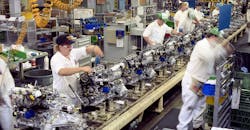Automotive Supplier Outlook Improves on USMCA, Trade Deal
According to a survey released by the Original Equipment Suppliers Association, automotive part suppliers’ outlook improved in the first quarter of 2020. The OESA’s Automotive Supplier Barometer Index, or SBI, jumped 10 points from 37 points in Q4 2019 to 47 points in Q1 2020. A score of 50 on the index is considered neutral. The jump corresponds with the passage of the United States-Mexico-Canada-Agreement, or USMCA, as well the phase one trade deal with China signed January 15.
Key takeaways from the survey include the assessment that part suppliers are more likely to rate poor vehicle sales as more threatening than changing trade policy. Smaller firms with revenue below $150 million with less exposure to business overseas were more positive than larger companies, which remained pessimistic on net.
Digging into responses to the survey reveals a significant decrease between Q4 2019 and Q1 2020 respondents who said they felt “somewhat more pessimistic” on their three-month business outlook. That was accompanied by slighter increases in those whose opinions were “unchanged” or “somewhat more optimistic.”
Auto suppliers are also now less likely to see their business as threatened by external factors, and what they did feel threatened by shifted. Respondents to the survey were asked to grade eight factors on a scale from 1 to 10, with 1 indicating the “greatest threat” and 10 designating “smallest threat.” In October, the most threatening category was “changes in government trade policy,” with an average rating of 3.2. In February’s numbers, suppliers rated that same category a 4.9. The new most threatening issue, as suppliers see it, is “Poor sales of vehicles in programs supplied,” with an average rating of 4.2—rated at an entire point less threatening than the greatest perceived threat at the end of last year.
Respondents sang a familiar tune when it came to the job market though. The top three issues identified as “severe” that suppliers said they would face while meeting required levels of production were “engineering talent or availability,” “skilled labor shortages,” and “hourly labor shortages.” The OESA survey received a number of comments from respondents emphasizing suppliers’ preoccupation with finding qualified workers: “Skilled labor continues to be the greatest challenge in our industry,” said one.
The survey included some figures relevant to the future of battery-powered electric vehicles, or BEVs. 75% of respondents said that new customers and technologies are driving BEV innovation, but 69% saw program profitability as a challenge. Most suppliers expect that BEV production will take between five to ten years to make up 10% of global vehicle output. They also expect BEVs will be mostly made in China at first, with production in Europe and North America to follow later.
About the Author
IW Staff
Find contact information for the IndustryWeek staff: Contact IndustryWeek
